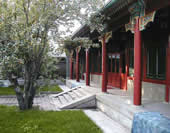
Former Residence of Guo Moruo
- Travel to Former Residence of Guo Moruo Former Residence of Guo Moruo is situated in a traditional courtyard (Siheyuan) on the west bank of Shichahai, with a gold wooden tablet engraved by Deng Yingchao on east gate identifying it. It is one of the courtyards of famous people in Beijing. Guo Moruo, a renowned Chinese writer, poet, dramatist, scholar, historian and paleographer, spent the remaining 15 years of his life there. The courtyard is now used as a museum, with the east and west wing-rooms being applied to showrooms of the life of Guo Moruo. Guo Moruo made fantastic contributions to Chinese culture and science. He moved into the courtyard at Shichahai in November 1963, and remained there until his death on June 12th, 1978. Formally as a garden of a prince of the Qing Dynasty (1644 -1911), the courtyard was designated as a cultural relic in 1982 on Guo's 90th Birthday Anniversary, and opened to
Former Residence of Guo Moruo is situated in a traditional courtyard (Siheyuan) on the west bank of Shichahai, with a gold wooden tablet engraved by Deng Yingchao on east gate identifying it. It is one of the courtyards of famous people in Beijing. Guo Moruo, a renowned Chinese writer, poet, dramatist, scholar, historian and paleographer, spent the remaining 15 years of his life there. The courtyard is now used as a museum, with the east and west wing-rooms being applied to showrooms of the life of Guo Moruo. Guo Moruo made fantastic contributions to Chinese culture and science. He moved into the courtyard at Shichahai in November 1963, and remained there until his death on June 12th, 1978. Formally as a garden of a prince of the Qing Dynasty (1644 -1911), the courtyard was designated as a cultural relic in 1982 on Guo's 90th Birthday Anniversary, and opened to
 the public as a museum in 1988. Now, the museum stands as a reminder of the live and works of Guo Moruo, with poetry, manuscripts and the flowers that were planted during his life. Guo Moruo loved nature. The flowers and plants Guo Moruo and his wife planted continue to flourish. On the lawn in north end of the courtyard stands a gingko tree, which Guo Moruo called "the national tree of China" and "a living monument to Chinese culture." There is a short story behind this tree. In 1954, Yu Liqun, Guo Moruo 's wife, left Beijing for medical treatment. Missing her very much, Guo Moruo brought a tree seedling from a forestry center and planted it in his courtyard at 5 Dayuan Lane in Xicheng District. He named it the Mother Tree. Guo Moruo taught his children to water and trim it and asked them to pray for the early recovery of their mother. When the family moved in 1963, they also moved
the public as a museum in 1988. Now, the museum stands as a reminder of the live and works of Guo Moruo, with poetry, manuscripts and the flowers that were planted during his life. Guo Moruo loved nature. The flowers and plants Guo Moruo and his wife planted continue to flourish. On the lawn in north end of the courtyard stands a gingko tree, which Guo Moruo called "the national tree of China" and "a living monument to Chinese culture." There is a short story behind this tree. In 1954, Yu Liqun, Guo Moruo 's wife, left Beijing for medical treatment. Missing her very much, Guo Moruo brought a tree seedling from a forestry center and planted it in his courtyard at 5 Dayuan Lane in Xicheng District. He named it the Mother Tree. Guo Moruo taught his children to water and trim it and asked them to pray for the early recovery of their mother. When the family moved in 1963, they also moved
the tree to the new courtyard. The Mother Tree is flourishing to this day and is heavy with fruit every autumn.The grounds are spacious and contain a double courtyard house, which is preserved much the way Guo Moruo left it at his death. The buildings include his office and living quarters, his wife’s paingting studio. An unusual feature is that several of the structures are connected by heated corridors, which was a luxury in Beijing in those days.On the lawn is a bronze statue of Guo Moruo, a work by Situ Zhaoguang, a well-known sculptor and professor at the Central Academy of Fine Arts, on the 10th anniversary of Guo Moruo's death. The shining statue of Guo gazes forever at the Mother Tree.Here are some guide information for your tour to Former Residence of Guo Moruo: Address: 18 West Road, Front Sea, Xicheng District, Beijing. Admission Fee: CNY20, CNY10 for school students, Openning Hours: 09:00-16:30 (Closed on Monday), Contact Number: 86-10- 66125984, 66125392 (You need to book tickets two weeks early)
Former Residence of Guo Moruo Tour
More Tours- 1-Day Beijing Former Homes Tour
 Code:BT13
Code:BT13 From:$25
From:$25
Trip Highlights: Attractions involved: the former residence of Guo Moruo, the former Residence of Mei Lanfang, the Former Residence of Song Qing Ling. As the political and culture center of the country, Beijing has many celebrities s...
Your Question & Quick Answer*Design Your Own Trip
Beijing Top Attractions
Beijing Travel Information
Our Service
Booking Procedures | Terms & Conditions | Payment Methods | Links | Site Map | About Us | Contact Us | Travel Agent
Copyright 2008, All rights reserved.. itourbeijing.com professional Beijing tour operator and China travel service
TEL: 86-10-85711972 (Universal) 1-888-288-9328 (North America) E-mail: contact@itourbeijng.com
Tours Index | China Tours | Beijing Tours | Xi'an Tours | Shanghai Tours | Guilin Tours | Tibet Tours
China Travel | Beijing Travel | Shanghai Travel | Xi'an Travel | Guilin Travel |The Great Wall Tours
China Golf | Beijing Golf | Shanghai Golf | Xiamen Golf | Beijing Map | Beijing Side Trip | Yangtze Cruise | Travel Picture



